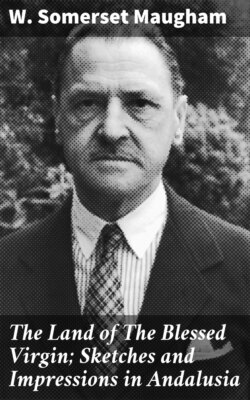Читать книгу The Land of The Blessed Virgin; Sketches and Impressions in Andalusia - W. Somerset Maugham - Страница 4
На сайте Литреса книга снята с продажи.
II
ОглавлениеTable of Contents
The Churches of Ronda
That necessity of realism which is, perhaps, the most conspicuous of Spanish traits, shows itself nowhere more obviously than in matters religious. It is a very listless emotion that is satisfied with the shadow of the ideal; and the belief of the Andaluz is an intensely living thing, into which he throws himself with a vehemence that requires the nude and brutal fact. His saints must be fashioned after his own likeness, for he has small power of make-believe, and needs all manner of substantial accessories to establish his faith. But then he treats the images as living persons, and it never occurs to him to pray to the Saint in Paradise while kneeling before his presentment upon earth. The Spanish girl at the altar of Mater Dolorosa prays to a veritable woman, able to speak if so she wills, able to descend from the golden shrine to comfort the devout worshipper. To her nothing is more real than these Madonnas, with their dark eyes and their abundant hair: Maria del Pilar, who is Mary of the Fountain, Maria del Rosario, who is Mary of the Rosary, Maria de los Dolores, Maria del Carmen, Maria de los Angeles. And they wear magnificent gowns of brocade and of cloth-of-gold, mantles heavily embroidered, shoes, rings on their fingers, rich jewels about their necks.
In a little town like Ronda, so entirely apart from the world, poverty-stricken, this desire for realism makes a curiously strong impression. The churches, coated with whitewash, are squalid, cold and depressing; and at first sight the row of images looks nothing more than a somewhat vulgar exhibition of wax-work. But presently, as I lingered, the very poverty of it all touched me; and forgetting the grotesqueness, I perceived that some of the saints in their elaborate dresses were quite charming and graceful. In the church of Santa Maria la Mayor was a Saint Catherine in rich habiliments of red brocade, with a white mantilla arranged as only a Spanish woman could arrange it. She might have been a young gentlewoman of fifty years back when costume was gayer than nowadays, arrayed for a fashionable wedding or for a bull-fight. And in another church I saw a youthful Saint in priest's robes, a cassock of black silk and a short surplice of exquisite lace; he held a bunch of lilies in his hand and looked very gently, his lips almost trembling to a smile. One can imagine that not to them would come the suppliant with a heavy despair, they would be merely pained at their helplessness before the tears of the grief that kills and the woe of mothers sorrowing for their sons. But when the black-eyed maiden knelt before the priest, courtly and debonair, begging him to send a husband quickly, his lips surely would control themselves no longer, and his smile would set the damsel's cheek a-blushing. And if a youth knelt before Saint Catherine in her dainty mantilla, and vowed his heart was breaking because his love gave him stony glances, she would look very graciously upon him, so that his courage was restored, and he promised her a silver heart as lovers in Greece made votive offerings to Aphrodite.
At the Church of the Espirito Santo, in a little chapel behind one of the transept altars, I saw, through a huge rococo frame of gilded wood, a Maria de los Dolores that was almost terrifying in poignant realism. She wore a robe of black damask, which stood as if it were cast of bronze in heavy, austere folds, a velvet cloak decorated with the old lace known as rose point d'Espagne; and on her head a massive imperial diadem, and a golden aureole. Seven candles burned before her; and at vespers, when the church was nearly dark, they threw a cold, sharp light upon her countenance. Her eyes were in deep shadow, strangely mysterious, and they made the face, so small beneath the pompous crown, horribly life-like: you could not see the tears, but you felt they were eyes which would never cease from weeping.
I suppose it was all tawdry and vulgar and common, but a woman knelt in front of the Mother of Sorrows, praying, a poor woman in a ragged shawl; I heard a sob, and saw that she was weeping; she sought to restrain herself and in the effort a tremor passed through her body, and she drew the shawl more closely round her.
I walked away, and came presently to the most cruel of all these images. It was a Pietà. The Mother held on her knees the dead Son, looking in His face, and it was a ghastly contrast between her royal array and His naked body. She, too, wore the imperial crown, with its golden aureole, and her cloak was of damask embroidered with heavy gold. Her hair fell in curling abundance about her breast, and the sacristan told me it was the hair of a lady who had lost her husband and her only son. But the dead Christ was terrible, His face half hidden by the long straight hair, long as a woman's, and His body thin and all discoloured: from the wounds thick blood poured out, and their edges were swollen and red; the broken knees, the feet and hands, were purple and green with the beginning of putrefaction.
